Before you go out
Try not to go out unless you are fit and able to carry out your journey safely.
Avoid going out if you are under the influence of drink or drugs. Wear glasses or hearing aids if you need them when out on the road. Always wear or carry something white or light-coloured or reflective in the dark or in poor light. This is particularly important on roads without pavements. Reflective material can be seen in headlights from up to three times the distance of ordinary clothes; fluorescent material is highly conspicuous in daylight and at dusk but is of little use in the dark.
Out and about
When using any roads and pavements, you must take proper care not to put yourself or any other person in danger. To use the roads safely, you should read and follow the rules and advice in this chapter.
Where there is a pavement or footpath, use it. Do not step onto, stand or walk on the roadway if at all possible. When using the pavement, keep away from the kerb. Avoid walking close to the kerb with your back to the traffic.
Look out for entrances and exits of driveways. Before crossing a driveway, look all around for approaching traffic and listen. If there is no approaching traffic likely to use the driveway, walk straight across it. Do not loiter in a driveway.
You must not enter or walk in a tunnel area or control area, except taking or alighting from a franchised bus at a bus stop. Traffic signs are erected to mark the beginning and end of tunnel area or control area (see page 73 for the signs).
You must not enter or walk within the boundaries of an expressway or light rail area. Traffic signs are erected to indicate their start and end points (see pages 71 and 111 for the signs).
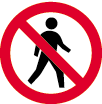 |
You must not walk past a traffic sign banning pedestrians or walk in the road to which the ban applies. These signs are often found near elevated roads, flyovers and underpasses. Even if there is no such sign, do not enter or walk along such roads unless there is a specially provided pavement.
|
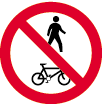 |
|
Walking at night
When walking at night, try to keep to the pavement areas with the best street lighting.
At night, although you can see the headlights of a vehicle, the driver often cannot see you. When the road surface is wet and shiny, reflections and glare can make it even more difficult for the driver to see you.
Drivers become tired more easily at night and their abilities to concentrate and see decline. It is also difficult for pedestrians to judge the speed and distance of approaching traffic.
There is a tendency at night for drivers to be momentarily and partially blinded by the headlights of approaching vehicles. This means, for example, that it is even more dangerous to stand on the roadway between traffic lanes at night than in the daytime.
When it rains
Visibility will be reduced by rain. It helps if your raincoat, other clothes and umbrella are of a light, bright colour that show up easily on rainy or foggy days.
Road surfaces become slippery when it rains. Braking and stopping distances of cars and other vehicles increase and so they cannot stop quickly. You are also more likely to slip.
|
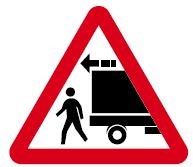
|
Warning sign - Beware of reversing vehicles
The sign is installed on cul-de- sac or narrow service road where there is frequent reversing of goods vehicles into or out of the road. You may be forced to walk on the roadway due to narrow footpath. Look all around for traffic, in particular, reversing vehicles, and take special care of children/the elderly.
|
Where there is no pavement
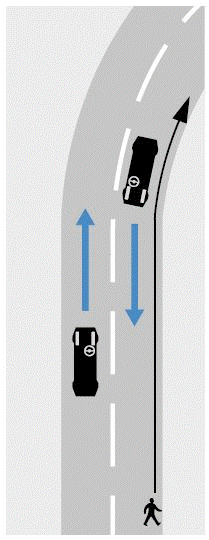 |
If there is no pavement on either side of the road, use the right-hand side of the road as much as possible to face oncoming traffic, and if practicable keep off the roadway and walk on the verge.
If it is necessary to stand or walk on the roadway, do so in a position where you can see the approach of traffic and where approaching drivers can also see you. On a normal two-way road, this is the right-hand side facing oncoming traffic.
Keep as close as possible to the side of the road. When walking with others, keep in single file if possible, particularly in heavy traffic or in poor visibility. Take special care at right-hand bends and on the brow of a hill where visibility is poor.
Walk on the side of the road where you can take refuge by stepping off the road if traffic comes. If this means walking with your back to the traffic, keep looking behind you to watch out for traffic and keep listening at all times. Make sure approaching drivers can see you.
|
Closed pavements
|

|
If the pavement is closed or blocked due to road works, look out for temporary diversion signs or alternative routes.
If there is no alternative to the pavement and you have to step onto the roadway, you should follow the advice for walking on roadway. If the blockage or closure is for a long distance, cross to the other side of the road following the Road Crossing Code (see page 8). If the obstruction is only for a short distance, it may be safer to walk on the roadway without crossing to the other side, even though this may mean walking with the traffic from behind.
Look all around for traffic before stepping onto the roadway; often watch out for traffic from behind you and return to the open pavement as soon as possible.
|
Footpath adjoining cycleway
|
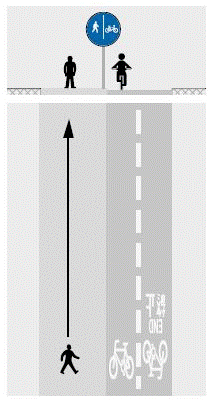
|
Do not walk on cycleways which are for cycles. Walk only on footpath and keep away from the edge of cycleway. Look out for cyclists if you need to step onto or cross a cycleway (see pages 38 and 39 for information on the traffic signs and road markings used to mark footpaths and cycleways).
|
Emergency vehicles
Keep off the roadway if you see or hear the approach of ambulances, fire engines, police or other emergency vehicles with their lights flashing or their two-tone horns or sirens sounding. If crossing the road, try to complete your crossing, or return to the pavement or side of the road as soon as possible. If you are still on the pavement, do not start to cross until you are sure that all the emergency vehicles have passed and no more traffic is coming. Emergency vehicles may not follow all the traffic rules or obey all the traffic signs and signals if life is at risk.
Outside fire stations and other places housing emergency vehicles, there may be special traffic light signals (wig-wag signal - two horizontal traffic signal aspects showing alternating red flashing light, see page 106) which will be switched on in an emergency to stop the traffic and allow the emergency vehicles to leave. When the two red lights are flashing, keep clear of the driveway in front of the station as soon as possible until the lights are off.
Using Roads and Pavements





